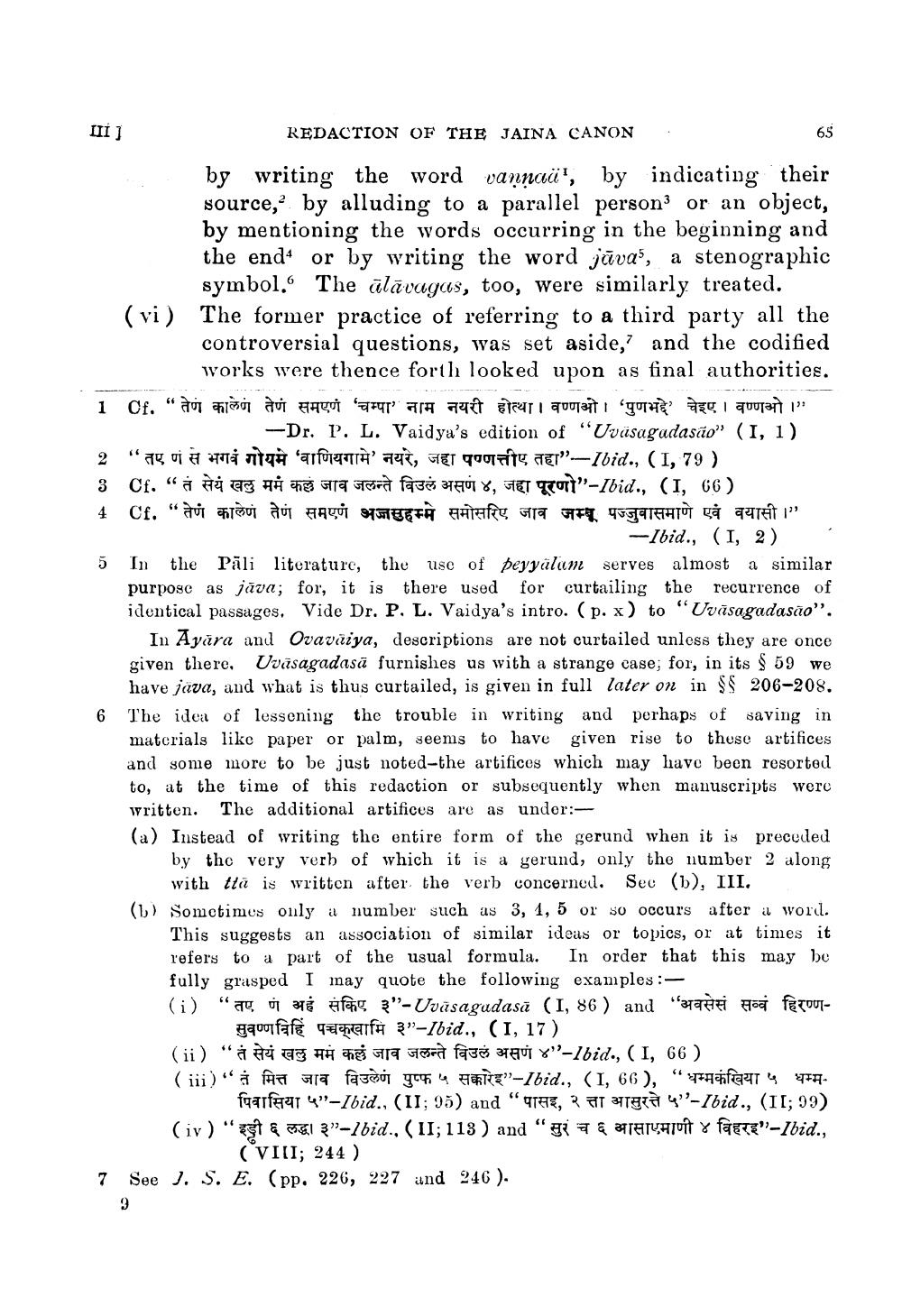________________
III ] REDACTION OF THE JAINA CANON :
65 by writing the word vannaü', by indicating their source, by alluding to a parallel person or an object, by mentioning the words occurring in the beginning and the end* or by writing the word jāva', a stenographic
symbol. The ūlāvagas, too, were similarly treated. (vi) The former practice of referring to a third party all the
controversial questions, was set aside, and the codified
works were thence forth looked upon as final authorities. 1 Cf. "au faro au 'FT ara 79€ Bicari qoutait "OTH #gi qoutart":
-Dr. P. L. Vaidya's edition of "Uvüsagadasão" (1, 1) 2 "aui 19H 'af ' 70, ATT Tourity I"--Ibid., (I, 79 ) 3 Cf. “M i es hi to Eta Tera fase BTA , FET TOTI"-Ibid., (I, C6) ___Cf. "तेणं कालेण तेणं समएणं अजसुहम्मे समोसरिए जाव जम्बू पज्जुवासमाणे एवं वयासी।"
-Ibid., (1, 2) 5 In the Pāli literature, the use of peyyalam serves almost a similar
purpose as jāva; for, it is there used for curtailing the recurrence of identical passages. Vide Dr. P. L. Vaidya's intro. (p. x) to "Uvāsagadasão”.
In Ayåra and Ovavaiya, descriptions are not curtailed unless they are once given there, Uvasagadasā furnishes us with a strange case; for, in its $ 59 we
have java, and what is thus curtailed, is given in full later on in SS 206-208. 6 The idea of lessening the trouble in writing and perhaps of saving in
matcrials like paper or palm, seems to have given rise to these artifices and some more to be just noted-the artifices which may have been resorted to, at the time of this redaction or subsequently when manuscripts were written. The additional artifices are as under:(a) Instead of writing the entire form of the gerund when it is preceded
by the very verb of which it is a gerund, only the number 2 along
with ttä is written after the verb concernou. See (b), III, (1) Sometimes only a number such as 3, 4, 5 or so occurs after a word.
This suggests an association of similar ideas or topics, or at times it refers to a part of the usual formula. In order that this may be fully grasped I may quote the following examples :(i) “a pa af 3'-Uvāsagadasă (I, 86 ) and "The Hd FETOUT
gquuffe leaf 3"-Ibid., (1, 17) (ii) " 3 HH ATT fazo TAUTY!-Ibid., (1, 66 ) (ii) M T 519 facit 94 HETTE”-Ibid., (1, 66), " fat" 4
faTHAT 4"-Ibid., (II; 95) and “918, AT ET -Ibid., (11; 99) Cir $1 & "-Ibid., (11;113) and “gia & TTATHI y face"-Ibid.,
(VIII; 244 ) 7 See J. S. E. (pp. 226, 227 and 246 ).
9




